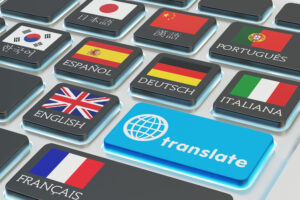As a result of the expansion of the borders of the European Union, the need for translation services has increased. To cope with the increasing volume of documents, translation service providers need software such as CAT Tools.
Globalization and the translation market
Analysts are unanimous in their opinion: the number of documents requiring translation will grow in the next ten years. True, opinions on specific volumes differ. The diversity of languages caused by the expansion of the borders of the European Union will lead, for example, not only to an increase in the number of translations of documents such as protocols or draft laws within the organizations of the European Union. It will also lead to increased demand for translations thanks to trading companies and processors, since in accordance with an EU regulation (Directive 79/112 / EEC) all technical documentation must be translated into national languages.
Globalization and the associated growth will lead to a colossal rise in the so-called GILT (Globalization, Internationalization, Localization and Transaction) sectors. The European Union of Associations of Translation Companies (EUATC) estimates that the translation market is expected to grow by about 5% annually in the coming years.
Despite the use of English as a lingua franca, further development is evident – the protection of cultures and languages. The translation market will undoubtedly benefit from this trend. Subsequently, due to the increasing acceptance of an increasingly multilingual population in the US and other countries, the demand for translation services will increase. In addition to these changes, technological innovation and an ever-growing range of products are in need of higher quality and more flexible translation agencies and translators.
Preparing for a shortage of translators
In the near future, the growing demand for translation services will increase as a result of the already existing shortage of specialist translators in many fields and with certain language combinations. International companies using foreign language translation services must be prepared to adapt or take appropriate action to avoid such a shortage. As part of its strategic orientation for the future, the company must first of all determine which texts will need to be translated in the next five to ten years and into which languages.
Some texts, such as presentations, marketing texts or even operating manuals for products sold around the world, are already available in English today, but only in English as it is permitted by law. This is because today’s addressees and users around the world have a better command of the English language. English will continue to establish itself as a common language in science and business communication.
However, by just choosing the right texts for translation into different languages, for example, for translation into German, French, etc., you can avoid facing the expected shortage of translators.
In the case of languages spoken only by relatively small groups of the population, for example, Estonian, Lithuanian, Kazakh, Armenian, it will be much more difficult to prevent a shortage of such specialists in the translation services market. The number of speakers of such languages, most likely, will not increase overnight. Promoting improvement and sustainability of continuing education opportunities can fill this gap. Translators and translation agencies offering language training services are highly dependent on support from businesses with their practical focus and specific materials on their products.
In addition, businesses using translation services will be more accessible to their translators in the future. As a result, the translator will be able to gain an understanding of the processes and style of the language in a business environment. Thus, businesses should view translation services as an investment and not just as a cost factor.
Due to the rapid increase in the number of language combinations in the field of text translation and the shortening of delivery times for services, professional project management and quality management will play a more significant role in the future. Provided that the latest technical capabilities are applied, translations are performed directly in the client’s CMS. Translation agencies can take on part of the project management tasks that are currently being performed at the enterprise. As a result, the interaction between enterprises and freelancers is expected to decrease, and cooperation with translation agencies will increase, since only the latter create the technical and organizational conditions necessary for large projects. Thus, in the future it will be a decisive factor for enterprises to cooperate with any translation bureau offering translations into more languages, for example, translation into German, Ukrainian, Kazakh, Azerbaijani, etc., and a wider technical spectrum.
Technological development
The growing number of documents requiring translation, and the increasing volume of translation, may be a hassle for many enterprises, but this fact can be seen as a certain advantage. Many text blocks are repeated on the basis of large volumes of translations. And therefore, it becomes more and more important to prepare documentation so that text elements can be used not only in the preparation of subsequent documents, but also in their translation, thus eliminating the need to translate these text elements anew each time. An effective data management system (DMS) and a content management system (CMS) are the main prerequisites for converting more cost-effective and terminologically consistent translations. This is the only way in the future it will be possible to meet the growing demand for quality.
The use of translation automation tools (CAT-Tools) will become essential for the creation of databases of terminology, glossaries, etc. Although at first glance it seems like a lot of time is spent on managing terms, the advantages for translators and enterprises are obvious: translators can process large volumes of texts faster and with less labor costs, while the client gets more control over the quality of translations into a foreign language that he does not speak.
The CAT-Tools market has changed a lot in recent years. Meanwhile, it is dominated by several large suppliers of such software products. In this regard, can we assume that enterprises need to choose a translation automation tool (CAT-Tool) from one major supplier to be sure that this product will not undergo changes in ten years?
Many believe that a few large vendors such as SDL, the makers of SDLX-Trados core software, will have to compete with smaller companies such as Alchemy, MultiCorpora, and Lingotek in the coming years. The latest software developments provide good alternatives to established programs, some of which exist based on their high-tech standard. Thanks to the proliferation of standards for projects (TTX, XLIFF), TM systems (TMX) or dictionaries (TBX), the choice of any translation program is less important today than it used to be. In the case of XML, a few years ago, the development went in a similar way. The program that was used at the time to process XML files no longer plays any decisive role today.
When choosing CAT-Tools, enterprises should place greater emphasis on their specific requirements for the functionality of the tool and not focus on compatibility.




